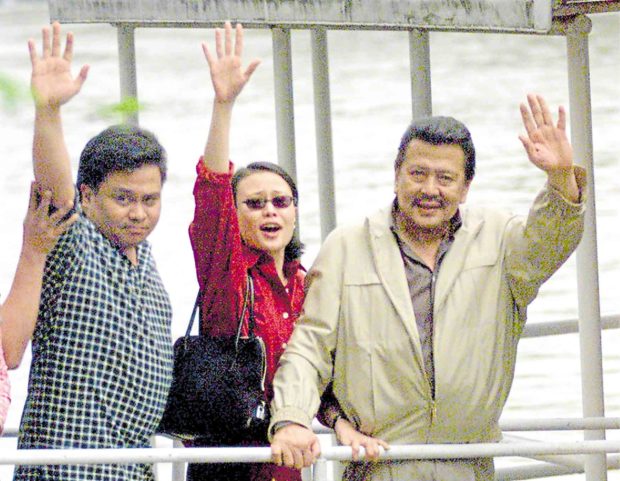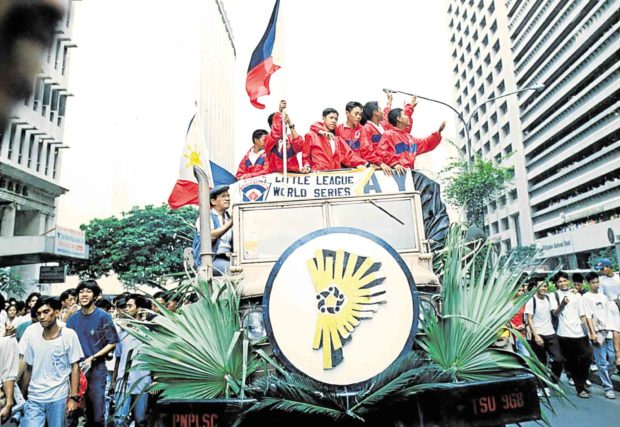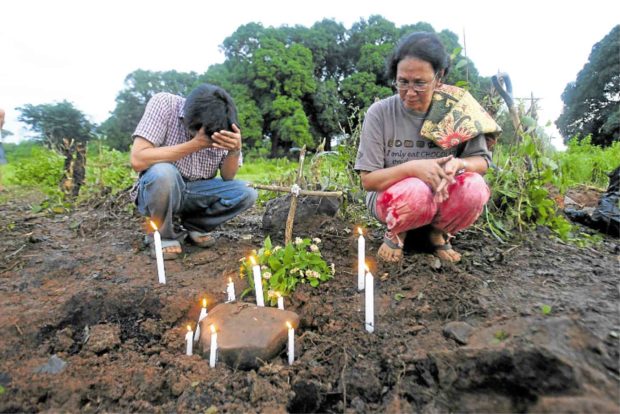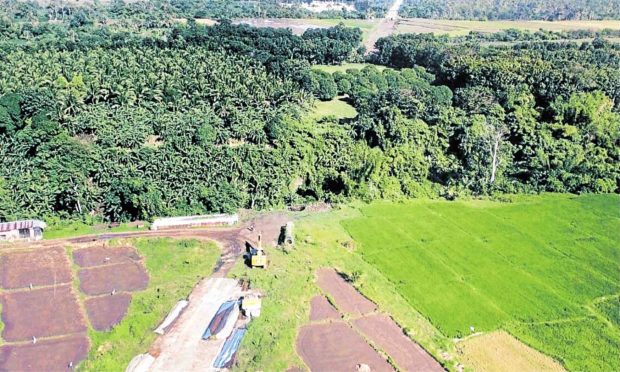Scoring scoops, getting results

DIARY OF A DOWNFALL The Inquirer’s publication of the diary of then Executive Secretary Edgardo Angara led to the Supreme Court ruling that ousted President Joseph Estrada had “effectively resigned” in January 2001, thus legitimizing then Vice President Gloria Macapagal- Arroyo’s ascent as his successor. —VAL HANDUMON
What makes a high-impact news report?
It could be that special sizzle of a scoop that shows how enterprising the reporter was, and how he or she would stop at nothing to get the story.
It could be the telling details—the color, quotes, mannerisms and milieu that define the characters behind the news—making the story so real and relatable to readers.
Or maybe it’s all about timing—running an in-depth piece on the right day or week, anticipating the public’s appetite for higher discourse or need for a more thorough explanation of the day’s issues.
For the Inquirer, it could be all that and more. In its 34 years of reporting the news, the paper has been known to go after agenda-setting stories—news reports that change the narrative, push policies, spur investigations, pinpoint accountability. A number have changed the course of our country’s history.
Take that three-part series on then Executive Secretary Edgardo Angara’s chronicle of President Joseph Estrada’s last days in Malacañang. The diary entries were later cited by the Supreme Court as its basis for saying that Estrada had “effectively resigned” and for unanimously upholding the legitimacy of Vice President Gloria Macapagal-Arroyo’s succession to the presidency in 2001.
Then there was the six-part report on the pork barrel scam published in 2013 that exposed how lawmakers had allowed their Priority Development Assistance Fund (PDAF) to be used in ghost projects in exchange for a cut.
Weeks after the exposé, an outraged public gathered for a “Million People March.” Then President Benigno Aquino III banned the use of private organizations as a conduit of public funds. The Commission on Audit (COA) came out with more damning revelations and state prosecutors filed plunder and bribery charges against three senators, five congressmen and some of their top aides.
The Supreme Court also declared the PDAF unconstitutional in a ruling that had since become the basis in deciding whether a budget insertion was legal or another form of pork barrel, repackaged and deodorized.
And what about the Dolzura Cortez story by Ceres Doyo published by the Inquirer in 1992? The report gave a Filipino name and face to the acquired immune deficiency syndrome (AIDS) for the first time and raised national awareness of the dread disease.
The Inquirer’s recent reports on how the Philippine Health Insurance Corp. (PhilHealth) had been defrauded by claims made in behalf of “ghost patients” also resulted in a Senate inquiry, a revamp in the state health insurer’s top management, and the filing of criminal cases.
The following are just some of the stories the Inquirer won’t tire retelling because of the magnitude of their impact, the action they triggered, and the change they inspired.
“Tasaday, a hoax–Salazar” by Roy de Guzman; Oct. 21, 1987
The Inquirer reported that Zeus Salazar, chair of the University of the Philippines Department of History, was disputing the claim of the Office of the Presidential Assistant for National Minorities, led by businessman Manuel Elizalde, that the Tasaday was an isolated and distinct ethnolinguistic tribe dating back to the Stone Age.
Elizalde had claimed to have discovered and helped the Tasaday two months before he decided to run in the 1971 Senate race—and lost.
The Tasaday controversy was already simmering in 1986, when UP sponsored an international conference on the subject. It was followed by a congressional investigation the next year.
“Alih Alive”; Feb. 9, 1989
After the government reported that he was killed by soldiers during an operation to take back a Philippine Constabulary (PC) headquarters in Zamboanga City from his group, Rizal Alih turned out to be very much alive.
In January 1989, Alih, a rogue police officer, led a group of men who took Brig. Gen. Eduardo Batalla and several other people hostage at the PC base in Camp Cawa-Cawa. The military laid siege to the camp three days later after Batalla was executed by his captors.
The Inquirer report that Alih was still alive led to a manhunt and the filing of murder charges against him. Alih was arrested in Malaysia for illegal possession of firearms in 1994 and was a convict serving a 14-year sentence when extradited to the Philippines in 2006. Detained at Camp Crame, he died in the camp’s hospital after complaining of chest pains in 2015.
“Garchitorena scam: Shady land deal in Bicol” by Danny Calleja; May 15, 1989
The Inquirer broke the Garchitorena land scam story in a mere one-column item. The report told of how the Aquino administration was almost conned of some P60 million through an overvaluation of a virtually barren estate in Garchitorena, Camarines Sur.
According to an editor, the reaction of some agrarian reform officials was “revealing” and “almost violent” as they practically went overboard “working on” everybody at the Inquirer, from senior editors down to the agriculture beat reporter.
This was the cue for the Inquirer to further work on the story. To get an exclusive, reporter Beth Pango and photographer Boy Cabrido hiked more than two hours on a moonless night across rugged terrain and communist rebel territory.
On June 26, 1989, Agrarian Reform Secretary Philip Juico resigned from the Cabinet, saying he wanted to spare President Cory Aquino from further trouble arising from the scandal.
“A story on AIDS: Meet Dolzura Cortez, PWA” by Ceres P. Doyo; Aug. 31 to Sept. 3, 1992
Dolzura Cortez was the first Filipino with full-blown acquired immune deficiency syndrome (AIDS) to come out and tell her story. Past interviews with Filipinos afflicted with AIDS had been on condition that no names were mentioned and no photographs taken.
Cortez allowed the publication not only of her name but also her picture. She also gave the Inquirer a photograph of herself before she got AIDS. Her before-and-after pictures showed readers how ravaging the disease could be.
The story gave AIDS a Filipino “name and face,” which drew tremendous response from readers and helped raise awareness of the disease. A movie was later made based on Cortez’s life.
“RP Little League: Zamboanga 6 not who they claim they are” by Artemio Engracia Jr., Carol Arguillas and Armand Nocum; Nov. 7-12, 1992
The six-part series was published shortly after the Zamboanga City team won the Little League World Series championship. Filipinos were swept on the crest of national euphoria. But word started going around that the boys were older than 12, the age limit for players in Little League baseball.
Digging up school and birth documents and cemetery records, and interviewing neighbors and schoolmates, among others, the report presented hard evidence of name switching, the use of imposter parents, and other details of cheating executed at every level to form a “champion” team.

BASEBALL SCANDAL The country’s little league baseball team was forced to forfeit its 1992 World Series championship after the Inquirer reported that some of the players were over the age limit and not based in Zamboanga, in violation of league rules.
The exposé’s impact came at a very painful price. Nocum, who hailed from Zamboanga, faced death threats and was ostracized in his hometown. He was forced to leave Zamboanga and settled in Manila. A number of readers and advertisers boycotted the Inquirer and the paper’s street sales and ad placements dipped considerably.
But after conducting several hearings, the Senate committee on sports confirmed the Inquirer story.
“Erap’s final hours told” by Edgardo Angara; Feb. 4-6, 2001
As the “Edsa Dos” uprising pressured President Joseph Estrada to leave Malacañang following his aborted impeachment trial, then Executive Secretary Edgardo Angara headed a panel that was formed to negotiate a peaceful transfer of power to then Vice President Gloria Macapagal-Arroyo.
Angara’s diary of the upheaval as felt at the Palace, published a month later in the Inquirer front page as a three-part series, chronicled the collapse of negotiations with the Arroyo camp.
In March that same year, the Supreme Court found Angara’s account to be “an authoritative window on the state of mind” of Estrada, and voted 13-0 to uphold the legitimacy of Arroyo as Estrada’s successor.
The tribunal quoted extensively from Angara’s narrative and used it as basis in concluding that Estrada had effectively resigned.
The end notes of the high court’s decision cited at least 30 more stories from the Inquirer.
The justices also voted 9-4 to declare that Estrada had lost his immunity from suit. Still citing Angara’s diary as basis, the high court later dismissed Estrada’s motion for reconsideration.
The historic ruling paved the way for the filing by the Office of the Ombudsman of plunder cases against Estrada. Placed under house arrest during his six-year trial, he was convicted in September 2007 and granted pardon by Arroyo the following month.
“Meet the ‘Powerpuff Girls’ of COA” by Volt Contreras; Nov. 3, 2003
The exclusive feature by Volt Contreras about an all-female Commission on Audit team got a lot of positive reactions from readers.
The state auditors were interviewed for the story after they received a government service award for discovering how Manila Electric Co. (Meralco) had wrongly included its income tax among the costs that could be recovered from consumers. The Inquirer story noted the challenges they faced while working on the case which led to the Supreme Court decision granting consumers a P28-billion refund.
The report inspired the inclusion of more “feel-good” stories as Page One material in the Inquirer.
“Palace payola: Gov bares payoff” by Tonette Orejas, Yolanda Sotelo-Fuertes, Juliet Labog-Javellana, Jhunnex Napallacan, Kit Bagaipo, Carla P. Gomez, Joey A. Gabieta, Marlon Ramos, Juan Escandor Jr., and Ryan Rosauro; Oct. 14, 2007
Then Pampanga Gov. Eddie Panlilio revealed that a Malacañang staff member had handed him a paper gift bag containing P500,000 in cash, after he attended a Palace meeting between President Arroyo and around 200 officers and members of the Union of Local Authorities of the Philippines.
An Inquirer source further confirmed that sums ranging from P20,000 to P500,000 were given to the governors and mayors in attendance—at a time when Arroyo was facing an impeachment complaint.
The report kicked up a storm, with no lack of advocates on either side of the moral divide. It also led to a Senate probe that tried to trace the real source of the bundles of cash stuffed in envelopes and brown bags.
“Human bone in Bataan Camp” by Nikko Dizon; Oct. 15, 2008
The exclusive report told of the discovery by a fact-finding team of what appeared to be a human bone in an area where Bulacan farmer Raymond Manalo claimed to have seen soldiers torturing several people.
Also discovered at the site were personal effects believed to have belonged to University of the Philippines student Karen Empeño and a companion, Manuel Merino, who by then had been missing for two years.

EVIDENCE VS ‘THE BUTCHER’ The Inquirer had a 2008 exclusive on a fact-finding team’s discovery of a piece of human bone, as well as some personal effects, that bolstered the case against then Army Maj. Gen. Jovito Palparan Jr. “The Butcher”was later sentenced to life imprisonment for the 2006 kidnapping and serious illegal detention of student activists Karen Empeño and Sherlyn Cadapan. —RAFFY LERMA
The findings bolstered the efforts of the mothers of Empeño and another UP activist, Sherlyn Cadapan, to doggedly pursue the case against Army Maj. Gen. Jovito Palparan Jr., who was called “The Butcher” by human rights advocates.
Palparan and three others were later charged with kidnapping and serious illegal detention in connection with the disappearances. He went into hiding before he could be arraigned in a Bulacan court, but was arrested in 2014.
In September 2018, Judge Alexander Tamayo found Palparan, former Army Lt. Col. Felipe Anotado Jr. and former Army S/Sgt. Edgardo Osorio guilty and sentenced them to a maximum prison term of 40 years (reclusion perpetua).
“Enrile’s Christmas gift” by Juliet Labog-Javellana; Jan. 9, 2013
The Inquirer reported that Senate President Juan Ponce Enrile gave 22 senators a total of almost P30 million just before Christmas in 2013. The cash gift allegedly came from the funds allotted for the Senate post vacated by Benigno Aquino III after he won the presidential election in 2010.
Eighteen senators each received P1.6 million, billed as “additional maintenance and other operating expenses” (MOOE), while four others with whom Enrile does not see eye to eye on matters both professional and personal, got only P250,000 each. They were senators Antonio Trillanes IV, Miriam Defensor Santiago, Pia and Alan Peter Cayetano.
The squabble among the senators turned uglier by the day as they hurled personal attacks against each other, further hurting the image of the Senate. Enrile proposed a review of the budgets of the Senate oversight committees with multimillion-peso allocations and the abolition of those that had become irrelevant.
On June 5, 2013, Enrile officially resigned as Senate President, saying the hate campaign against him involving the additional MOOE budget had eroded public trust in the Senate and had affected the senatorial bid of his son, former Rep. Jack Enrile. The younger Enrile lost the May 2013 senatorial race.
The “pork barrel scam” series by Nancy Carvajal; July 12-17, 2013
Carvajal’s six-part series reported the diversion of some P10 billion in 10 years by a syndicate using the PDAF of some senators and congressmen.
The reporter first got wind of the corruption scandal from a top agent of the National Bureau of Investigation, who was part of the task force that rescued Benhur Luy. He would later serve as one of the Inquirer’s key sources for the truckloads of evidence pertaining to the scam.
It took a village, so to speak, to fact-check and scrutinize the documents and whistleblowers’ affidavits. But the resulting investigative report and follow-up stories rocked the nation and led to unprecedented actions: the “Million People March,” a damning COA report, and a historic Supreme Court ruling. Three senators ended up being charged with plunder.
In the words of the late Inquirer editor in chief Letty Jimenez-Magsanoc, the pork barrel series was “one of the biggest stories in the (then) 28-year history of the Inquirer, next only to the Edsa People Power Revolution of 1986.”
“Complete records of Benhur Luy bared” by Nancy Carvajal; May 12-24, 2014
Ten months after the Inquirer broke the story on the pork barrel scam, Carvajal followed it up with a 13-part series on the transactions between lawmakers and Janet Lim-Napoles and her bogus organizations.
The source of the material were the digital records—totaling 20,103 files in 2,156 folders—kept by Benhur Luy and detailing transactions made from 2002 to 2012.
The records were among the evidence submitted by the National Bureau of Investigation to the Office of the Ombudsman in the plunder cases filed against Senators Juan Ponce Enrile, Ramon “Bong” Revilla Jr., Jinggoy Estrada and 74 others.
“Bangladesh cyberheist: P100-M laundering via PH banks, casinos probed” by Daxim Lucas; Feb. 29, 2016
The Inquirer scoop told of hackers stealing some $81 million from the New York accounts of the Bangladesh central bank, with the stolen fund successfully wired to a Makati branch of the Rizal Commercial and Banking Corp. (RCBC) and laundered in local casinos.
The Senate launched an inquiry into what was considered one of the world’s biggest cyberheists, while the Bangko Sentral ng Pilipinas slapped RCBC with a P1-billion fine. The bank, which maintained that the money laundering was the handiwork of the “rogue” Jupiter branch then under manager Maia Deguito, has since strengthened its internal controls.
In January 2019, Deguito was convicted of eight counts of money laundering by the Makati Regional Trial Court. Five other RCBC officials are facing money laundering charges.
Philippine casinos have since then been subjected to stringent reporting obligations under the antimoney laundering law.
“Yasay American, Filipino or stateless?” by Juliet Labog-Javellana; Feb. 27, 2017
The story was one of the paper’s biggest scoops in 2017. Documents obtained by the Inquirer showed that then Foreign Secretary Perfecto Yasay took his oath as an American citizen in 1986, contrary to his claims before the Commission on Appointments (CA) that he had never acquired US citizenship.
In his CA confirmation hearing, Yasay said that he had applied for naturalization but never legally acquired American citizenship. But on June 28, 2016, Yasay personally appeared before Vice Consul Kristy L. Haller at the US Embassy in Manila to formally renounce his US citizenship.
Because of the Inquirer story, the CA rejected Yasay’s nomination and effectively fired him after ruling that he lied about his American citizenship.
“Right of way problems plague road projects” by Maricar Cinco, DJ Yap and Delfin T. Mallari Jr.; Jan. 14 to 16, 2019
In January 2019, the Inquirer published a three-part special report on some big-ticket projects of the Department of Public Works and Highways (DPWH) that were suspended or not completed because of right of way (ROW) problems.
The special report also featured stories of landowners who have not received the promised compensation from the government. Aside from poor planning, many of the problems of the department were traced to corruption.
The report led to a Senate scrutiny not only of the DPWH projects but also the department’s entire budget. At a parallel inquiry at the House of Representatives, lawmakers also called on officials of the DPWH and the Land Registration Authority (LRA) to purge their ranks of people responsible for pulling off irregular ROW payments.

RIGHT OF WAY TURNS ‘NO WAY’ A special report in January 2019 detailed how “right of way” problems have been plaguing the government’s big-ticket infrastructure projects. Public works and land registration officials were taken to task in a Senate inquiry, while some of the affected landowners finally received compensation.
Some of the affected landowners finally received compensation after the publication of the stories, while Public Works Secretary Mark Villar pledged to address the right of way problems with dispatch.
“PhilHealth pays for ghost kidney treatments” by Leila Salaverria and Jovic Yee; June 6 to 8, 2019
In his last State of the Nation Address, President Duterte said he was “grossly disappointed” over the misuse of state health insurance funds on “ghost dialysis” treatments—a scheme brought to national attention by an Inquirer investigative report on the Philippine Health Insurance Corp. (PhilHealth).
The three-part series and follow-ups gained traction until a Senate probe was called and an investigation was launched into the medical centers that may have defrauded the state health insurance company from 2013 to 2018.
Arrested on estafa charges was the owner of the Quezon City-based WellMed Dialysis Center, who was accused of defrauding PhilHealth by submitting claims for patients who are already dead.
The Inquirer also reported on the use of fake PhilHealth receipts used to dupe overseas Filipino workers.
PhilHealth said it had filed more than 700 administrative cases against various health care providers for violating the agency’s rules and regulations.—REPORTS FROM MARIELLE MEDINA, ARIANNE SUAREZ, ANA ROA, KATHLEEN DE VILLA AND MINERVA GENERALAO, INQUIRER RESEARCH INQ SOURCE: INQUIRER ARCHIVES